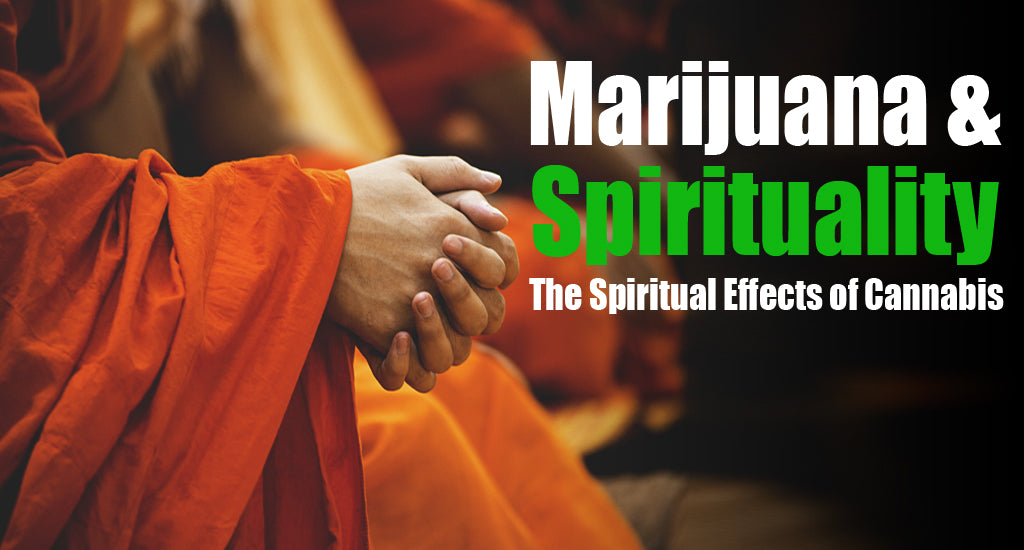
Unearthing the Mystical Connection: Cannabis, Spirituality, and the Journey Within
Exploring Cannabis as a Spiritual Tool
Working with cannabis can be a complex endeavor, especially given its widespread illegality. The plant's scientific potential, often likened to a path of 'enlightenment,' remains largely unexplored due to these legal restrictions.
Enlightenment, in broad terms, refers to a profound self-awareness and an understanding of one's surroundings. Despite the potential benefits, many of us haven't had the opportunity to utilize cannabis as a spiritual aid. Throughout history, various religions have integrated cannabis into their practices, using it as a guide for spiritual experiences. What unites these diverse traditions is not merely a devotion to their deities, but the shared goal of quieting the mind's chatter and focusing intentions on the present moment. The sense of inner tranquility often associated with marijuana use—or even meditation—is a simple yet potent reminder that our thoughts shape our reality. However, we must approach this principle cautiously, considering its potential pitfalls.
Exploring Society's Influence and Personal Narratives
Human beings are essentially born into a pre-established societal framework, akin to an operating system. A significant portion of our lives is spent unraveling the complexities of our internal programming. Questions like "Who am I?" and "What is my purpose?" are pondered by both shamans and atheists alike, reflecting a shared human quest for understanding.
More often than not, our actions are propelled by underlying narratives rather than genuine substance. These narratives operate beneath our conscious desires, exerting a subtle influence. Many world religions teach that by illuminating these unconscious desires, we can acquire the skills to navigate life more adeptly as awakened individuals. It becomes evident that to transcend these narratives and find genuine clarity, we must delve into the depths of our own consciousness, unearthing the guiding principles that shape our existence.
The Unconscious, Intention and Mary Jane
You might be wondering, why are we talking about all of this when we're discussing everyone's beloved herb: marijuana?
Using marijuana for meditative purposes, rather than solely for recreation, introduces a fascinating concept. This approach can be likened to a spotlight illuminating potentially erroneous beliefs, prompting a profound self-examination. Similar to peering into a mirror, it offers a deeper understanding of one's identity.
An analogy can be drawn from the practices of the Native American Church, where specific plants amplify intentions, enhancing their impact. Similarly, even in recreational usage, many individuals attest to marijuana's ability to alleviate stress and anxiety, facilitating relaxation and a more amiable demeanor.
In essence, marijuana serves a dual role – as a tool for introspection and a stress-reliever – revealing its versatile nature. Whether used contemplatively or casually, it offers a unique pathway to self-discovery and an avenue to foster a calmer, more genial state of mind.
Cannabis in different cultures/religions
-
Cannabis in Taoism: Shamans combined cannabis, mainly with ginseng, to unlock foresight, primarily among religious leaders. This practice, distinct from other beliefs, omitted cannabis from texts, possibly due to its exclusive role. Scholars theorize this could clarify the omission. In 200 C.E., the Han Dynasty's shift to Confucianism led to Taoism's abandonment and cannabis along with it. This transformation reflects the intricate interplay of cultural, spiritual, and botanical elements.
Shamans across cultures integrated herbs to amplify their effects, with cannabis and ginseng being a notable combination, sought after by religious authorities for glimpses into the future. Yet, unlike many faiths where cannabis featured prominently in rituals or texts, it remained conspicuously absent from the religious writings associated with these shamans.
The Han Dynasty's pivot highlights evolving views on cannabis. As Confucianism gained supremacy and Taoism waned, cannabis also lost its standing. This pivotal cultural shift underscores the dynamic relationship between changing societal norms, philosophical ideologies, and the role of certain plants within these contexts.
-
Cannabis in Buddhism: By 200 C.E., spiritual cannabis use declined in China, contrasting with its rise in India. In Indian lore, gods gifted cannabis to alleviate human suffering, enhancing joy and vitality. A significant spiritual narrative involves gods and demons jointly churning the ocean for immortality (amrita), favoring cannabis in Hinduism.
-
Cannabis in Ancient Greece: Cannabis held religious importance for ancient Scythians and Assyrians. Notably, the historian Herodotus from the 5th century documented these practices, detailing religious ceremonies of the Scythian tribes. According to Herodotus, these tribes conducted rituals within tent-like structures, igniting hemp plants for communal inhalation.
-
Cannabis in the Old Testament: Cannabis holds evident prominence in Eastern religious practices, yet indications suggest its presence in Judaic and Christian traditions as well. Polish etymologist Sula Benet introduced a groundbreaking idea, proposing that the Hebrew term "kaneh bosm" was mistranslated as "calamus," a fragrant plant. If accurate, this interpretation reshapes our perception of the Old Testament.
-
Cannabis in Jamaican Religion: Jamaica, renowned for Bob Marley and Rastafarianism, has a deep association with cannabis. Popularized by Marley in the U.S., the Rastafarian movement centers on the worship of Jah (God). Cannabis holds spiritual significance for Rastafarians, representing a rejection of materialism and oppression. However, their cannabis use faced scrutiny and legal challenges, leading to the 1993 Religious Freedom and Restoration Act. This act safeguarded the consumption of cannabis and other substances as a religious right.
Best 4 Strains & Practices for Meditation
Certain cannabis strains contain significant levels of THC, making them conducive to enhancing meditation sessions. These strains are often indica-dominant, inducing a range of effects from tranquility to heightened concentration.
However, responsible dosing aligned with your meditation objectives is crucial. The aim of cannabis-assisted meditation is to cultivate purposeful focus. It is my hope that these strains will yield rewarding outcomes for you, as they have for me.
Related article: 5 top tips to smoke weed and be productive
Please be aware that this compilation is not an exhaustive collection of meditative strains or techniques; it highlights those I have personally found notably advantageous. Similar to numerous other strains, these options can result in significant dry mouth. It's vital to maintain proper hydration consistently, not solely during cannabis consumption. Keep a water bottle handy – believe me, there's nothing more frustrating than losing focus midway through a creative endeavor due to the oversight of not refilling the Brita filter. And yes, I confess, that oversight was mine.
-
Kosher Kush: By nature, an indica strain, giving it typically less negative side effects compared to some stove strains. This strain gained notoriety in its early day with the aid of a story that claimed the plant had been blessed by a Rabbi. Kosher Kush has also been studied as an alternative to pharmaceuticals to aid with chronic pain, depress, anxiety, and even lack of appetite. Using this strain sends the consumer into a deep relaxation, reducing worries and eventually producing a sedentary effect. This strain is definitely meant for at-home meditation, best later in the day. Because of the onset of tiredness, this strain is best closer to bed. Be prepared for a rush of euphoric feelings before crashing into a solid 6-8 hours of the best sleep ever (More info about the strain here).
-
AK-47: Best described as uplifting, this strain offers a strong resolution to stress and anxiety—two of the most common sources of lack of concentration. Associated with many creative types, AK-47 creates an aura of focus allowing artists to delve deeper into their art. This safe-space creates a relaxed environment. Perfectly paired with groovy tunes, use this strain for intentional creative focus, or just to relax after a long day. Be careful though, AK-47 does tend to have quite a long effect, in comparison with other hybrids and is capable of deeply relaxing neuroses (More info about the strain here).
-
Jack the Ripper: Not all meditative practices involve deep relaxation. Some salivas have been known to completely kill exhaustion and induce energetic focus to keep the user motivated and concentrated. This strain is definitely meant for the go-getter who loves to get things done and take on whatever life throws away. The constant hustle-and -bustle of modern society can leave one completely drained mentally by mid-day. With a moderate strength of ’15-20%’, this strain is suitable walks of life (More info about the strain here).
-
Blue Dream: With a wide-array of effects, Blue Dream is suitable for healing. Overall, BD considered most helpful to those suffering with those who are suffering from recurring mental issues, from stress and depression to chronic headaches. Those who find themselves regularly exhausted, worried or upset, will find this a wonderful solution (More info about the strain here).
-
Northern Lights: At first sight, the actual Northern Lights, can be overwhelming. Much like it’s namesake, this strain is widely used medicinally for its peaceful and tranquil effects, with minimal adverse reactions. Quintessential for an evening smoke or just to unwind. Light the stars above, this strain will ignite your mind in moments of darkness. Describing this feeling as dreamy would not be too far off, sending smokers into an altered state of severe physical laziness. Better taken before bed. Also note, this strain has a real tendency to induce happiness and genuine smiling (More info about the strain here).
4 Practical Exercises to Consider
-
The Raisin Test: Here's a fun beginner's activity that's super easy. You can use any regular thing you like, but I suggest picking something small that you can easily hold in your hand. Imagine you've never seen this object before, like it's from outer space! What does it look like? How does it feel when you hold it? Does it have any smell, and does that remind you of something?
Let's take a raisin as an example. Yup, a tiny raisin! The cool thing is, it doesn't really matter what object you pick. The important part is to really focus your mind on just that one thing. This helps you stay in the present moment and stops your brain from wandering off into thoughts about the future. It's like a little mental workout that's also a bit like a game! -
Mindful Observation: Here's a cool and easy exercise to help your imagination grow stronger and make words feel like magic spells! Find a window with a nice view – like a big TV screen showing the world. Look at all the things outside, like leaves and cars. But here's the twist: instead of just thinking about the names of things, try to really see how they look.
Look at the colors and shapes. Notice how things feel with your eyes, like a secret detective exploring a new place. Watch how the wind dances with the leaves and how the grass bends like it's doing a stretch. Be like a curious scientist, paying attention but not judging or being too serious. If your mind takes a little trip, that's okay! Just come back to the view and keep going. This is like a fun game of focus and imagination that you can play anytime you want! -
Mindful Breathing: I've got a cool trick to share that I really enjoy. It's great when you're walking, but you can also do it while sitting still. Ready? Take a deep breath in through your nose, like you're smelling a yummy cookie for 6 seconds. Hold your breath for another 6 seconds, like you're holding a secret. Then, breathe out slowly through your mouth for 6 seconds, like you're blowing out candles.
While you're doing this, pay close attention to your breath. Feel your chest and tummy getting bigger and smaller. Now, here's the fun part: let your thoughts be like bubbles in a fizzy drink. They pop up, and that's totally fine! Watch them come and go, just like waves at the beach. No need to judge them or get worried. This is like a mini vacation for your mind that you can take anytime you want! -
Mindful listening: Here's a fun way to exercise your ears and your mind! You know how sometimes we hear things and we instantly think we know what they're like? Well, let's try something different. Imagine your ears are like detectives, and they're on a mission to discover new sounds without jumping to conclusions.
Start by closing your eyes, like you're getting ready for a secret adventure. Now, play some music – any kind you like, it doesn't matter. Forget about who's singing or what the song is called. Instead, focus on the beats – are they fast or slow? Then, check out the singer's voice – is it soft or powerful? Listen closely, like you're exploring a new world through your ears.
This is like being a music explorer, discovering new things in songs you've never noticed before. It's a cool way to let go of what you think you know and really enjoy the sounds around you!
Conclusion - Final Thoughts
Our minds are like super-powered engines that can do different things, like coming up with cool ideas, thinking deeply, or sometimes causing trouble. But you know what? We need to be careful about how we use our minds and what we put into them.
Sometimes we smoke something that makes us feel really good and happy, but we also need to be smart about it. Because just like having a bad dream can mess up a good day, one bad experience can spoil all the fun we were having.
Now, here's a secret trick: when you're feeling curious and kind, you can use different types of "stuff" to help you feel lighter and less worried. Facing your worries honestly is like finding a treasure map! You know, we all have times when we're scared, but that's totally okay.
A lot of us wear pretend masks because it's like seeing the world through foggy glasses. We might try to be happy, but deep inside, we're still worried. But guess what? We can learn to look through those foggy glasses and see things clearly.
It's like becoming a detective to figure out what's bothering you. And guess what? It's not a quick trick. It's like planting a little seed that grows into peace. So, remember, peace isn't magic, but it's worth the adventure!



